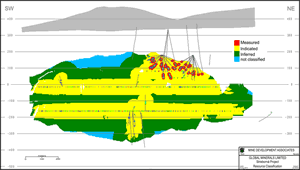Global Minerals Increases Strieborná Resource by 37 Percent
Global Minerals Ltd. (CTG – $0.09 & DFPN – €0.06) released an updated NI 43-101 resource estimate for its 100% owned Strieborná high-grade silver/copper/antimony vein project in Slovakia.
This new resource estimate incorporates 6,143 meters of additional drilling conducted since the last resource update and represents a 37% increase in measured & indicated silver resources and a 19% increase in tonnage. Moreover, the current resource is reported at a cut-off grade of 100 grams per tonne silver, whereas in previous estimates no cut-off grade was applied.
| Category | Tonnes (000) | Ag (g/t) | Cu (%) | Sb (%) | Ag (Ounces) | Cu (lbs) | Sb (lbs) |
| Measured | 132 | 267 | 1.32 | 0.98 | 1,134,000 | 3,836,000 | 2,844,000 |
| Indicated | 2,158 | 266 | 1.20 | 0.84 | 18,455,000 | 56,923,000 | 39,882,000 |
| M&I | 2,290 | 266 | 1.20 | 0.85 | 19,589,000 | 60,759,000 | 42,726,000 |
| Inferred | 872 | 211 | 0.98 | 0.69 | 5,915,000 | 18,761,000 | 13,338,000 |
| The new Strieborná resource estimate. A cut-off grade of 100 g/t was applied. | |||||||
Metallurgical Tests
Next on the agenda are final results from metallurgical test work on samples from the Strieborná vein. Initial reports show recovery rates of 90 to 95% for silver and copper by conventional flotation.
Global is also evaluating if it’s more economical to remove the antimony, which is found in the concentrate, by using a hydrometallurgical treatment process, or if it’s better to ship the concentrate to the smelter containing the antimony. This is important because antimony is considered a pollutant by most smelters and they will charge a fee per percentage of antimony in the concentrate. On the other hand, producing antimony as a by-product can have a significant economic benefit although the hydro-met process will add capital and operating costs as well.
Once these studies are finished, an economic assessment of the project will be finalized.
Antimony
Antimony is a lustrous grey metallic-looking solid, with intermediate to relatively good electrical conductivities.
China is by far the largest producer of antimony with about 80% of the world’s supply. Followed by Russia, Myanmar, Canada and Bolivia. According to the United States Geological Society (USGS), total production of antimony in 2012 was 180,000 tonnes.
The overall production rate in China has slowed in recent years, as the government has closed down many antimony mines. Additionally, the Chinese government has declared antimony a strategic metal and has introduced quantitative and export licensing restrictions in 2010.
Based on the current usage, antimony reserves will run out in the next 8 to 12 years. The largest mine, accounting for over 50% of China’s production, is expected to come to the end of its mining life in 5 years.
Moreover, although several new antimony mine projects are being evaluated and developed in countries like Armenia, Australia, Canada, China, Georgia, Italy, Laos, Russia, and Turkey, they will all take plenty of time to come to market.
About 60% of antimony production is consumed in flame retardants for products such as children’s clothing, toys, aircraft and automobile seat covers. Approximately 20% is used in alloys for batteries, plain bearings and solders. Additionally, it forms a highly useful alloy with lead, increasing its hardness and mechanical strength. Even more important, antimony is increasingly being used by the military to harden ordnance and lead in storage batteries, making it a strategic metal.
 |  |
| Antimony crystal | Antimony 5-year price chart. Copyright MetalPrices.com |
Because of the expected supply shortage and the increasing strategic use of the metal, the British Geological Survey (BGS) has placed antimony on top of a list which contains 52 materials or elements of economic and lifestyle value that are most at risk from supply threats. Also, the European Union has identified antimony as one of 12 critical raw materials in a report published in 2011, primarily due to the lack of supply outside China.
As a result of reduced production and increased demand, the price of antimony, which is evaluated by specialist publications and providers, such as Fastmarkets, rose from $4,000 per tonne early in 2009, which was the lowest price for nearly four years, to a current price of over $10,000 per tonne.
Based on the new resource estimate, Strieborná contains about 56 million pounds of antimony, which equals approximately 25,000 tonnes. If we take the current market price for antimony into account, we reach a gross market value of $250 million. Of course, this is a gross number which will never be reached because some parts of the resource won’t be mined and because a certain percentage is lost during the leaching process. Nevertheless, it gives an idea of the potential value of the by-product.
Conclusion
This is a nice resource increase, especially taking into account that this time a cut-off grade of 100 g/t was applied, which wasn’t the case before. The additional work and drilling during the past 12 months, also gave the Company a better understanding of the mineralization and the continuity and predictability of the vein.
The economic studies, which are currently being conducted, are very important. Adding a treatment facility to recover the antimony from the concentrate will add a certain cost, but looking at the potential gains from the sale of the by-product it’s probably well worth it.
 |
| Notes to figure: Gray shaded area is topography; gray lines are drill holes; colored area is the extent of the defined vein; colored points within vein are underground samples. |
| Smallcaps.us Advice: Buy | Price Target: $0.29 | Latest Company Report (pdf) |
| For important disclosures, please read our disclaimer. |

